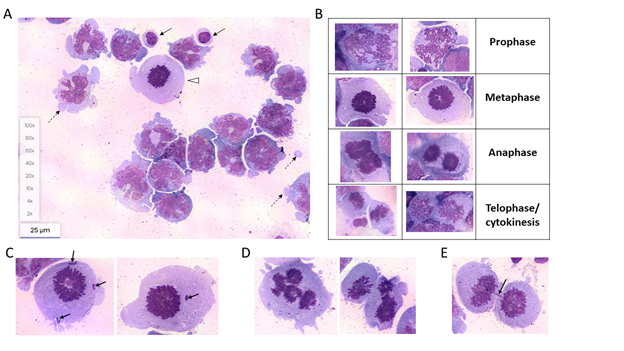The Generation of Chromosomal Alterations During Mitosis in Primary Central Nervous System Diffuse Large B-cell Lymphoma
Article Information
Ben-Zion Katz1,2,3, Dan Benisty1,2, Chen Glait-Santar1,2, Chava Perry1,3 and Sigi Kay1,2
1Division of Hematology, Tel Aviv Sourasky Medical Center, Tel Aviv, Israel
2Division of Clinical Laboratories, Tel Aviv Sourasky Medical Center, Tel Aviv, Israel
3Sackler Faculty of Medicine, Tel Aviv University, Tel Aviv, Israel
*Corresponding Author: Ben-Zion Katz, Division of Hematology, Tel Aviv Sourasky Medical Center, Tel Aviv, Israel
Received: 09 September 2023; Accepted: 24 October 2023; Published: 15 November 2023
Citation: Ben-Zion Katz, Dan Benisty, Chen Glait-Santar, Chava Perry and Sigi Kay. The Generation of Chromosomal Alterations During Mitosis in Primary Central Nervous System Diffuse Large B-cell Lymphoma. Archives of Clinical and Medical Case Reports. 7 (2023): 377-378.
Share at FacebookAbstract
A 51 year old male patient was diagnosed with primary central nervous system (CNS) non-germinal center B-cell (non-GCB) diffuse large B-cell lymphoma (DLBCL), with approximately 50% of Ki-67 positive cells. Morphological examination of the cerebrospinal fluid (CSF) at presentation revealed population of large cells, some with basophilic cytoplasm and disordered nuclear structure. 7-8% of the cells were in various stages of mitosis. Mitosis in this specimen was profoundly synchronized, with 81% of the cells in metaphase, and the rest of mitotic forms were in other stages of mitosis. As shown, individual chromosomes split from metaphase plates during metaphase, disordered metaphase plates generate aneuploidy during anaphase, and chromosomes may physically split during cytokinesis. All the alterations observed in this specimen occurred simultaneously, pointing to an extensive mechanism that drives rapid genetic diversity in this highly aggressive CNS lymphoma. The patient was treated with chemo-immunotherapy followed by autologous bone marrow transplantation, and is currently in remission.
Keywords
Chromosomes; Diffuse Large B-cell lymphoma; Mitosis
Article Details
Case Report
A 51 year old male patient was diagnosed with primary central nervous system (CNS) non-germinal center B-cell (non-GCB) diffuse large B-cell lymphoma (DLBCL). A brain biopsy indicated a diffuse infiltration of the parenchyma with large atypical cells. The cells were found positive for CD20, CD79a, Bcl6, and negative for CD5, CD10, Bcl2, MUM1 and Cyclin-D1. Approximately 50% of the cells were Ki-67 positive. Bone marrow biopsy was found negative for lymphoma involvement. Lumbar puncture was performed, and the cerebrospinal fluid (CSF) cell count was high, with indication of a presence of both mononuclear cells and polymorphonuclear cells. Morphological examination (Scopio Labs X100 analyzer, 100X magnification, A) of the CSF at presentation revealed a population of large cells, most with basophilic cytoplasm and disordered nuclear structure. One of the typical cytological characteristics of CNS lymphomas is the presence of lymphoglandular bodies in the tissue [1]. As shown in Figure 1A (dashed arrows), the malignant cells display large numbers of cytoplasmic protrusions, some are cells free, which may provide the origin for such lymphoglandular bodies. 7-8% of the cells in the specimen were in various stages of mitosis (B). The mitoses were profoundly synchronized, with 81% of the cells in metaphase (A, arrowhead), and the rest of mitotic forms were in other stages of mitosis, including prophase, anaphase, and telophase/cytokinesis (B). We show herein that in some of the dividing cells individual chromosomes split from metaphase plates during metaphase (C, arrows), disordered metaphase plates generate aneuploidy during anaphase (D), and chromosomes that may physically split during cytokinesis (E, arrow). Some normal lymphocytes were also observed (A, arrows). DLBCL is an aggressive lymphoma characterized by accumulation of molecular and genetic alterations [2]. Among the reported genetic alterations in primary CNS lymphomas are copy number variations and recurrent structural variations [2]. Aneuploidy was previously reported in 7.14% of primary CNS lymphomas [3]. All the chromosomal alterations observed in this specimen occurred simultaneously, pointing to an extensive mechanism that drives rapid genetic diversity in this highly aggressive CNS lymphoma. The patient was treated with chemo-immunotherapy followed by autologous bone marrow transplantation, and is currently in remission. This unique specimen provides an insight into the extensive generation of genetic diversity, which is fundamental for the progression of this high grade hematological malignancy.
Figure 1: Abnormal mitosis of Diffuse large B-cell lymphoma (DLBCL) cells in the cerebrospinal fluid (CSF). A. Cytospin preparation of CSF from a patient with primary central nervous system (CNS) DLBCL. Note the large cells, with basophilic cytoplasm and disordered nuclei structure. Arrows: normal lymphocytes; Dashed arrows: membrane protrusions (some are cell-free); Arrowhead: mitotic cell in metaphase. B. Phases of mitosis observed in the specimen: prophase, metaphase, anaphase, telophase/cytokinesis. C. Separation of individual chromosomes (arrows) from the mitotic plate. D. Generation of aneuploidy during mitosis. E. Split of a chromosome (arrow) between daughter cells during cytokinesis.
References
- Sugita Y, Muta H, Ohshima K, et al. Primary central nervous system lymphomas and related diseases: Pathological characteristics and discussion of the differential diagnosis. Neuropathology 36 (2016): 313-324.
- Radke J, Ishaque N, Koll R, et al. The genomic and transcriptional landscape of primary central nervous system lymphoma. Nat Commun 13 (2022): 2558.
- Koriyama S, Nitta M, Shioyama T, et al. Intraoperative Flow Cytometry Enables the Differentiation of Primary Central Nervous System Lymphoma from Glioblastoma. World Neurosurg 112 (2018): e261-e268.

